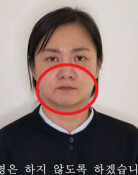Former Comfort Women Still Suffering
Former Comfort Women Still Suffering
Posted August. 15, 2006 03:13,
Back in the days, the roofs used to be weaved using hay. Now theyre steel boards.
On Sunday in front of the History Hall of Japanese Military Comfort Women at the House of Sharing, a former comfort woman Moon Pil-gi, 81, patted a picture of her hometown of Jinju, Gyeongnam Province, and cried.
Why is she crying while looking at a picture of her hometown when she can go and see the place herself in just half a day?
When I went there, people would ask me about my painful memories. I cried a lot because I knew people were whispering behind my back.
Over 30 years ago, Moon left her hometown, unable to endure the coldness of her neighbors any longer. Since then, she has been occasionally visiting her mothers grave to serve her a cup of soju and would then hasten out of town. She was too keen on not being seen that she couldnt quite take a good look at her hometown.
Moon lives with other former comfort women at the House of Sharing in Gwangju, Gyeonggi Province. The house held an exhibition on Monday of photos for the women of their hometowns. The exhibition is called Roots and Sad Spite in commemoration of the Liberation Day.
Accepting the houses request, two photographers took 300 pictures of the 17 comfort women across the country for a month as a gift to them.
Lee Ok-sun, 79, doesnt go back to her hometown anymore. She was forced to go to China as a comfort woman and couldnt return until 2000, when she finally regained her citizenship. However, people at her hometown where she went back after 58 years tore her heart to pieces.
She survived the sexual violence and deep cuts on her ankles and wrists by Japanese soldiers with the sole resolve to return home alive. However, the people back home treated her coldly, which hurt her badly.
My relatives said, Why did you come back? You should have lived and died there [at the House of Sharing]. Its embarrassing for you to come back. I wanted to die.
The scorching heat cannot stop the women from looking at the pictures. They pat and pat the pictures, as if simply looking at them isnt enough.
Park Ok-sun, 82, who looked at the picture for a long time, went on and on about her hometown, saying, Across the bridge right here, there was a temple. If you go this way, you could see an Arirang tombstone.
imsun@donga.com







